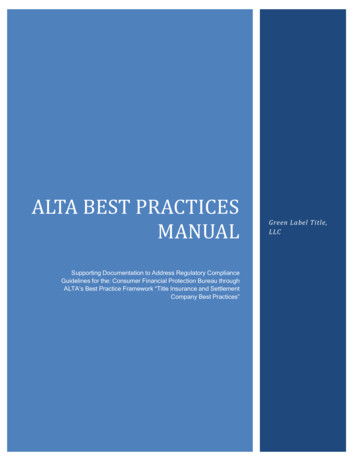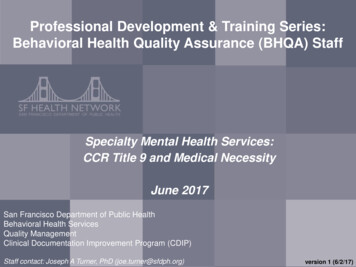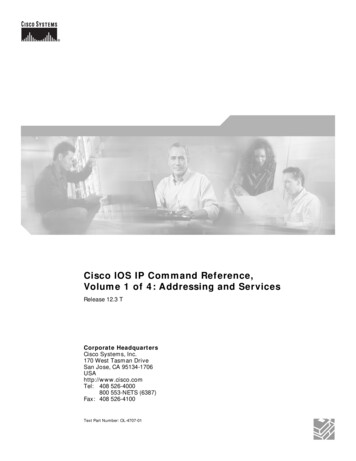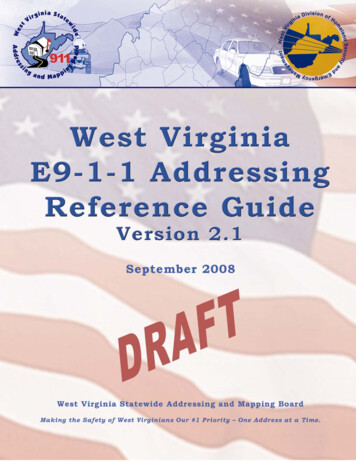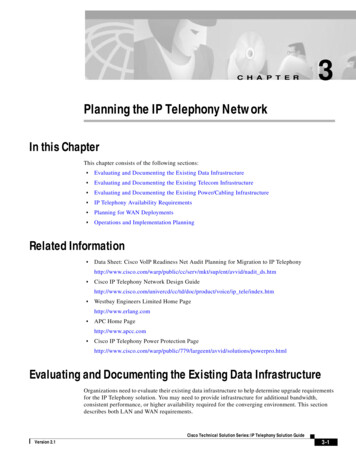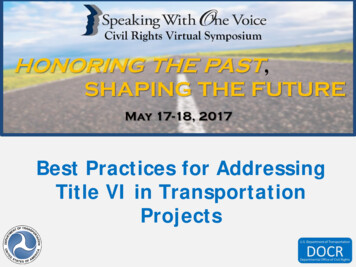
Transcription
Best Practices for AddressingTitle VI in TransportationProjects
Your Speakers Moderator – Jon Ocana, Equal Opportunity Specialist,Policy, Education, and Training Division, DepartmentalOffice of Civil Rights Presenter – Kevin L. Resler, National Title VI ProgramCoordinator, Federal Highway Administration Office ofCivil Rights Presenter Dawn Sweet, Director, HeadquartersOperations Division, Federal Transit AdministrationOffice of Civil Rights Presenter – John Lozada, Manager of Federal Programs,Office of Diversity and Civil Rights, MassachusettsDepartment of Transportation2
Purpose of the Session The goal of this session is to highlight thedevelopment and implementation of Title VIbest practices. Presentation of methods to incorporate Title VIprinciples early to avoid unnecessary delay andcosts. Share best practices rooted in wideapplicability and maximum benefit torecipients and the public.3
Title VI Program ReviewEssentials2017 USDOT Virtual CivilRights SymposiumKevin L. ReslerNational Title VI Program CoordinatorFederal Highway AdministrationOffice of Civil RightsKevin.resler@dot.gov
Learning Objectives1. Understand specific State andLocal Requirements.2. Understand legal theories ofdiscrimination and complaintprocedures.3. Discuss nondiscrimination inpractice.5
Title VI BasicsWhat is the law?“No person in the United States shall, on theground of race, color, or national origin, beexcluded from participation in, be denied thebenefits of, or be subjected to discriminationunder any program or activity receiving Federalfinancial assistance.” Title VI of the Civil Rights Act of 1964; 42U.S.C. § 2000d, et seq.6
Title VI Basics: Civil Rights RestorationAct of 1987 Rejected 1984 Supreme Court decision in Grove CityCollege v. Bell (465 US 555) “Program or activity” means all of the operations—anypart of which is extended Federal financial assistance—of:– a department, agency, special purpose district, or otherinstrumentality of a State or of a local government; or– The entity of such State or local government thatdistributes such assistance and each such department oragency (and each other State or local government entity)to which the assistance is extended, in the case ofassistance to a State 42 U.S.C. § 2000d-4a(1).7
Title VI Basics: Case LawAlexander v. Sandoval, 532 U.S. 275 (2001) Held the Title VI statute does not provide a private right ofaction in civil court for disparate impact. The private rightof action is only for disparate treatment. However, the Court recognized federal agencies may enactdisparate impact regulations, which are enforceable by thefederal agency. E.g. persons may file a Title VI disparateimpact complaint pursuant to USDOT regulations (49 C.F.R.§21.5 (b)(2)), a Letter of Finding may be issued, andenforcement actions taken by the grantor federal agency.8
Title VI Basics: Other Notes Title VI doesn’t apply to employment, unless Federalassistance is specifically for employment. Cross-cutting laws and protected categories beyond race,color, national origin are part of the FHWAnondiscrimination program under 23 C.F.R. Part 200 but areenforced through their own authorities. E.g. recipientsmust ensure nondiscrimination for “low income” personsunder EJ Executive Order, but individuals cannot file Title VIcompliant for only that status. Title VI applies to benefits and burdens.9
Title VI Roles and Responsibilities FHWA– Provides stewardship and oversight– Approves Implementation Plans and conducts processreviews– Provide policy and technical assistance training State DOTs– Perform required actions under 23 C.F.R. Part 200– Submit annual Plan, assurances, and Report to FHWADivision– Conducts internal and external reviews– Process and investigate complaints against subrecipients10
Title VI Roles and Responsibilities:Local Public Agency Recipients Conform to State DOT Implementation Plan, including:– Collection and analysis of demographic data to ensurenondiscrimination– Complaint procedures– Training requirements– Limited English Proficiency policies– Submit annual assurances to State DOT and use contractinserts– Submit reports on demographic data requested from StateDOT Assist in State DOT external reviews11
Title VI: Key State DOT Requirements Implementation Plans– States “shall annually submit an updated Title VIimplementing plan to the Regional Federal HighwayAdministrator for approval or disapproval.” 23 CFR§200.9(b)(11).– Due by October 1 each Federal Fiscal Year– Submitted even if changes are minor– Accompanied by signed assurances Title VI Coordinator Annual internal program area reviews / Data Collectionand Analysis. 23 CFR 200.9(b)(4-5). Subrecipient Reviews. 23 CFR 200.9(b)(7).12
Title VI: Key State DOTRequirements (cont’d.) Complaint processing and investigation. 23 CFR200.9(b)(3).– See FHWA External Complaint ms/finalcomplaintmanual110410.cfm) Internal training for State Program Managers. 23CFR 200.9(b)(9). Limited English Proficiency Plan. Executive Order13166. Environmental Justice. Executive Order 12898.13
Legal Theories of Discrimination What is discriminationunder Title VI?“No State shall make orenforce any law which shallabridge the privileges orimmunities of citizens of theUnited States; nor shall anyState deprive any person oflife, liberty, or property,without due process oflaw; nor deny to any personwithin its jurisdiction theequal protection of thelaws.” U.S. Const. amend.XIV, § 1.– Disparate Treatment– Disparate Impact14
Legal Theories of Discrimination:Disparate Impact Facially neutral procedure or practice; Disproportionate impact on protectedindividuals; and A causal connection exists between policy andthe impact. Often shown through statistical data. In addition, the practice lacks a substantiallegitimate justification and a reasonablenondiscriminatory alternative could not beidentified.15
Title VI – Ensuring Compliance inPractice: RiskWhat is the Risk?If Recipients lack good data,analysis, and reviewprocedures, they can: Adversely impact the public,and Will not be prepared torespond to USDOToversight.16
Title VI – Ensuring Compliance inPractice Civil Rights practitionersmust be conversant inproject development(planning, NEPA, etc.) anddata analysis. Checklists and forms areuseful to roll up informationbut must work inconjunction with in-depthreviews. “Interdisciplinary” meansmeeting face-to-face withother disciplines andreviewing material together.Collect dataandinformationAct onfindings17Analyze
Title VI – Ensuring Compliance inPractice: Example Review Methods Threshold or Representation analysis comparesdemographics to actual distribution of benefit/burden(e.g. project alternative route selection). Barrier analysis to test whether practices have adisproportionate, adverse impact, acting as a barrier toparticipation (e.g. venue for public meetings). Selection analysis to determine whether the selectionrate for one demographic group of beneficiaries islower than other groups (e.g. selection of consultants).18
Title VI – Ensuring Compliance inPractice: Data to collect and analyze Think from perspective of the public andbeneficiaries. Where and how do you contact public? Where are your contracts; who with? Where does the Recipient spend its funds? Have formal or informal complaints or publiccomments been submitted?19
Title VI – Ensuring Compliance inPractice: Risk-Based Approach Internally: processreviews to include “deskaudit” and data analysis. Externally: use selectionmethod best suited foryour program. Samplingand weighting criteria areacceptable. But,remember risk can comefrom the smallestsubrecipients.20
Title VI – Review Analysis ExampleHypothetical:Minority residents in the City of Madeupare concerned that FHWA grants toimprove roads and sidewalks near schoolsare disproportionately awarded to schooldistricts with non-minority students. Theresidents do not wish to file a formalcomplaint, but they would like FHWA toinvestigate.21
Title VI – Ensuring Compliance inPractice: Data and Analysis What data and informationyou need to proceed?– Data on applicant schools anddemographics over reasonabletimeframe.– Information on policies andprocedures.– Interviews with schools andpublic officials What analytical frameworkcan you use?– Statistical disparate impacts: Selection Analysis: applicantsand selectees. Threshold/Barrier Analysis:actual applicants and availableapplicants22
Title VI – Ensuring Compliance inPractice: Good Review Practices Anticipate Are interdisciplinary Use both data andinformation Are continuous anditerative23
Learning Objectives Recap1. Understand specific State andLocal Requirements.2. Understand legal theories ofdiscrimination and complaintprocedures.3. Discuss nondiscrimination inpractice.24
Thank You25
Title VI and Public Transit:Implementation Themes2017 Civil RightsVirtual SymposiumDawn SweetDirectorHeadquarters Operations DivisionFTA Office of Civil Rights
About FTA Provides funding and technicalassistance to local publictransit systems:– Buses, subways, light rail,commuter rail, and ferries– Also State DOTs, MPOs, etc. 12 billion annually to localcommunities – large/small,urban/rural27
FTA and Civil RightsMission Ensure FTA grantees complywith all Title VI requirements(49 CFR Part 21)Oversight Approach Onsite compliance reviews Complaint investigations Title VI program submission bygrantees (every 3 years)28
The Customer: The Public Transit is critical to the public– Connector to jobs, education,social opportunities Title VI communities oftenmore transit-dependent andchoice riders29
The Framework: Title VI Circular Circular 4702.1B: “Title VIRequirements and Guidelinesfor Federal TransitAdministration Recipients” Audience is transit providersbut the general principles andformat can potentially bereplicated in other areas30
Circular HighlightsCh. 3: General Requirements Public notice Complaint procedures Public participation Language access Monitoring of subrecipientsCh. 4: Service and Fare Equity(SAFE) Analysis Transit-specific requirement Applies to larger fixed routetransit systems (50 vehicles /200,000 population) Must evaluate the impacts ofproposed fare and majorservice changes on minoritypopulations31
Effective ProgramsProactive:Integrated: More difficult to make changes afterthe fact Public participation is key General nondiscrimination appliesto all activitiesTitle VITailored:Documentation-heavy: Locally developed programs Reflective of size and activities Policies and procedures Application and consistency32
Trend: Intersectionality Overlap among civil rightsprograms Don’t silo or view therequirements in a vacuum Two-way street examplesdisability– Language assistance for LEPpersons needed in ADAparatransit– Public participation process /locations must be accessible topeople with disabilitiesADATitle VIracelimitedEnglishproficiency33
QuestionsContact Us Tool(www.transit.dot.gov)
Massachusetts Department of TransportationA Peer Perspective onBest Practices for Addressing Title VI inTransportation ProjectsJohn Lozada, Manager of Federal Programs, Officeof Diversity and Civil Rights, MassachusettsDepartment of Transportation35
Title VI Challenges Building proactive Title VI awareness across state DOT andtransit leadership, managers and staff on civil rightsrequirements Understanding USDOT modal policies on Title VI demandsknowledge of federal regulations and policy, but creativityto support transit and highway initiatives Engaging FTA and FHWA on complex questions requiresrefinement of issues and solid analysis before engaging Establishing internal transportation enterprise networks iscritical to ensure comprehensive Title VI thinking Proactive communication and nurturing relationships withproject partners and key stakeholders is required to buildtrust and support on projects36
MassDOT/MBTA Title VI Background In 2009, Massachusetts Department of Transportation (MassDOT) wascreated, establishing a full multimodal enterprise that includes theMassachusetts Bay Transportation Authority (MBTA) MassDOT’s Office of Diversity and Civil Rights deepened strategic TitleVI compliance activities in 2011, hiring a Title VI Specialist supportHighway, Registry and State Managed Transit Title VI Programs In 2014, MassDOT submitted Title VI Programs for Highway, Statemanaged Transit and MBTA that share a base Public Participation andLanguage Access Plan In 2016, MBTA hired a Title VI Specialist, in response to the 2012 FTATitle VI Circular and new compliance requirements37
Areas of Innovation in Title VI Coordinated MPO compliance – shared MassDOT Title VI practices with 13Metropolitan Planning Organizations statewide, translated key documentsinto 10 languages, and built SharePoint site for resource sharing andposting Title VI Programs. Developed “Engage” software for Public Participation, with features toidentify languages spoken, accessible meeting locations and email links for5,000 community based organizations. Collaborated with FTA and FHWA leading to Civil Rights Specialist playinglead role on Title VI within federal MPO Certification Reviews Expanding MassDOT assessments of functional areas for compliance withFHWA Title VI requirements to MBTA public facing departments Built a software tool for civil rights compliance on ADA self-assessment38
Examples of Effective Engagementwith FTA and FHWA Civil Rights Responding to Major Complaints – terminationof late night service, commuter rail cancellations Developing Complex Policy – DisproportionateBurden/Disparate Impact Policy; Youth Pass Pilotextension Building technology based platforms forcompliance Identifying “best practices” across providersnationwide MPO Certification Reviews39
Key Strategic Considerations FTA Title VI Circular – offers ample guidance, but does not coverevery situation; ask FTA questions when a gap is identified Support leadership and departmental managers to know civil rightsrequirements, express operational challenges to compliance andbuild confidence to engage USDOT modal representatives Establish multidisciplinary Title VI team, to thoroughly analyzesituations and focus questions for advice. Research and study “best practices” across providers to comparewith situation presented Refine policy questions, identify alternative solutions and impact oflegal or regulatory requirements before seeking USDOT modalagency advice40
Wish List for USDOT Innovation E-library of Civil Rights Investigations, Reviewsand Policy Guidance to build consistent practices Blog for interactive sharing with other Transitand DOT partner agencies on substantive issues Directory of Civil Rights Leadership for State DOTand Transit agencies for ease of communication Regularly sharing “Best Practice” and updates oncivil rights activity Develop policy to unify Title VI Programdocuments to limit redundancy and risk of publicconfusion41
Questions42
MassDOT's Office of Diversity and Civil Rights deepened strategic Title VI compliance activities in 2011, hiring a Title VI Specialist support Highway, Registry and State Managed Transit Title VI Programs In 2014, MassDOT submitted Title VI Programs for Highway, State managed Transit and MBTA that share a base Public Participation and


